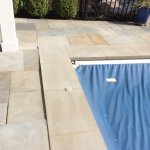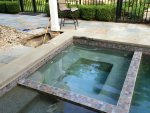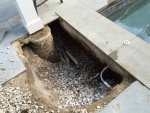I've surfed the net for hours, including this site and haven't found a definitive answer to my quest to fix a hairline leak in hot tub section of my pebble Tec / SWG pool.
I've had American Leak find the leak since it was so slow and difficult to find. Once found I realized it is a 2 foot horizontal hairline leak. American was going to put the underwater two part epoxy over it but I held them off due to the stark white obvious line it would make. They told me to drain the hot tub and use 100% silicone. I was skepticle of how long silicone would last underwater in this application. It's a small leak 1/4 inch day sort of leak so I'm not interested in overkill and could easily drain hot tub to update repair every 2 years or so. By the way, the pebble Tec in my hot tub is smooth Grey and not the typical granular colored pebble Tec used (which I did use on the adjacent pool).
With that said, any suggestions for the material/epoxy I should use? Comments on the use of silicone?
I've had American Leak find the leak since it was so slow and difficult to find. Once found I realized it is a 2 foot horizontal hairline leak. American was going to put the underwater two part epoxy over it but I held them off due to the stark white obvious line it would make. They told me to drain the hot tub and use 100% silicone. I was skepticle of how long silicone would last underwater in this application. It's a small leak 1/4 inch day sort of leak so I'm not interested in overkill and could easily drain hot tub to update repair every 2 years or so. By the way, the pebble Tec in my hot tub is smooth Grey and not the typical granular colored pebble Tec used (which I did use on the adjacent pool).
With that said, any suggestions for the material/epoxy I should use? Comments on the use of silicone?




